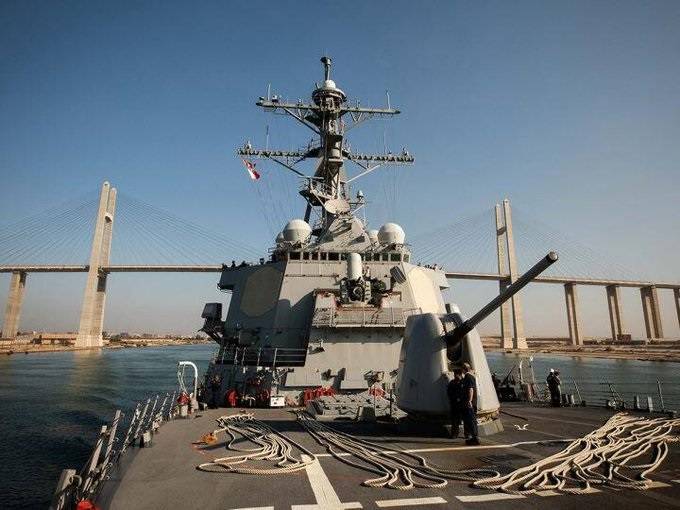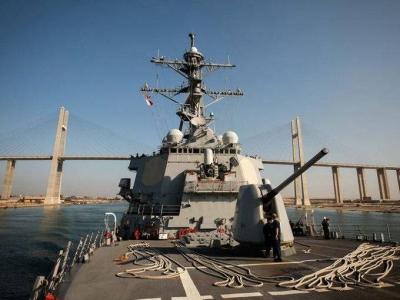U.S. warships in the Red Sea are facing an increasing number of weapons launched by Houthi forces in Yemen over the past few weeks, including an incident on Saturday when an American destroyer shot down more than 12 drones. The U.S. confrontations with the Houthis, who claim to be targeting commercial ships heading to Israel following its invasion of Gaza, may widen after Defense Secretary Lloyd Austin announced a new U.S.-led operation focused on protecting commercial vessels operating in the Red Sea and Gulf of Aden on Monday. The U.S. Navy did not specify which weapon systems its ships are using against Houthi attacks, but experts stated that "the American destroyer has a range of weapon systems at its disposal."
Experts noted: "These include surface-to-air missiles, explosive projectiles, and close-in weapon systems." They also mentioned that "U.S. ships have electronic warfare capabilities that can sever the links between drones and their control units on shore." Experts added: "Whatever systems the captains of American destroyers use, they face decisions regarding cost, inventory, and effectiveness as the mission grows." John Bradford, a fellow for international affairs at the Council on Foreign Relations, pointed out that "drones are slower and can be struck with cheaper missiles or even the ship's gun, whereas faster missiles must be intercepted with more advanced interceptors."
Global Economic Losses
The Iran-backed Houthi forces have conducted numerous attacks against American interests in the region and Israel since Hamas's attacks in Israel on October 7, amidst ongoing fears across the region of a potential widening of the war between Israel and Hamas. The group stated that "any ship heading to Israel is considered a legitimate target," while exerting pressure on Israel to cease its offensive against Gaza. They have launched multiple drone and missile attacks on commercial ships and attempted to land commandos via helicopter on one ship to hijack it.
The largest container shipping companies in the world have temporarily halted transit through one of the world’s key trade arteries, which experts say could "disrupt supply chains and drive up shipping costs." Companies like MSC, Maersk, CMA CGM, and Hapag-Lloyd recently announced they would avoid the "Suez Canal due to safety concerns." Oil giant BP followed suit, driving up oil and gas prices on Monday. In an interview with CNN, former CIA Director David Petraeus said, "This is one of the most important arteries in the world regarding maritime shipping," adding that "the time and cost of transporting goods around Africa will be substantial," which will have a significant impact on the global economy.
Guided-Missile Destroyers
In light of these attacks, the U.S. Navy stated that it "will rush to assist commercial ships in distress." The main U.S. assets engaged in the Red Sea to counter the attacks on ships are guided-missile destroyers like the USS Carney, which shot down 14 Houthi drones on Saturday. Its missiles include: Standard Missile (SM-6), Standard Missile (SM-2), Evolved Sea Sparrow Missile (ESSM). Experts believe that "the U.S. is using SM-2 and/or ESSM missiles against Houthi threats so far."
Expensive Munitions
However, as they are facing drones that can be produced and deployed in large numbers for less than $100,000, the prolonged campaign may eventually tax American resources, experts say. Alessio Patalano, a war and strategy professor at King’s College, stated, "These advanced air intercept capabilities have an average cost of about $2 million, making intercepting drones cost-ineffective." Experts point out that "Houthi forces are funded and trained by Iran, so they have the resources for an extended fight."
Experts also noted that "it's also about how far the U.S. wants to go to protect commercial shipping." The Phalanx system on the American destroyer, which can fire up to 4,500 rounds per minute, can handle drones or missile threats within a mile of the warship, according to Carl Schuster, a former U.S. Navy captain and former director of operations at the Joint Intelligence Center of U.S. Pacific Command in Hawaii. This is relatively low-cost defense. But if drones get that close, that’s the last line of defense, and a mistake could cost American lives.
Bradford stated, "A single missile or drone won't sink a U.S. warship, but it can kill people and/or cause damage that requires the ship to withdraw for repairs in port."
Warships vs. Protecting Commercial Vessels
The Phalanx system cannot protect commercial ships that the American destroyer may be monitoring, as they sail miles away from the warship. Siddharth Koushal, a naval power research fellow at the Royal United Services Institute in London, stated, "To provide extensive air defense (rather than self-defense), ships primarily rely on anti-aircraft missiles." Koushal explained: "The American anti-aircraft intercept missiles on U.S. warships are fired from vertical launch system (VLS) cells located on the ships." He added, "Each cell can hold a mix of weapons (exact numbers are classified), but the number aboard any ship is determined."
Experts say that "the Houthis have not yet attempted a real swarm drone attack, akin to what Russia has repeatedly attempted in Ukraine – an assault that could involve dozens of incoming threats at one time."
Helping Allies
Experts pointed out that "the U.S.-led operation to increase the number of warships protecting commercial vessels will aid defensive efforts." In a virtual ministerial meeting on Tuesday addressing maritime security in the Red Sea with representatives from 42 other countries, Secretary Austin stated that "these reckless Houthi attacks represent a serious international problem... and require a firm international response." He added, "These attacks threaten the free flow of commerce and put innocent sailors at risk... they must stop."
The day before, Austin announced the establishment of Operation "Guardian of Prosperity" in the Red Sea, a multinational operation that also includes the UK, Bahrain, Canada, France, Italy, the Netherlands, Norway, Seychelles, and Spain.
Potential Threats
While increased cooperation among allies may help, experts said that "deploying anti-ship cruise missiles or ballistic missiles may pose a new challenge." Anti-ship cruise missiles can fly at low altitudes and penetrate the ship's structure above the waterline. Experts say, "The U.S. may eventually decide that it has to move towards offense."




